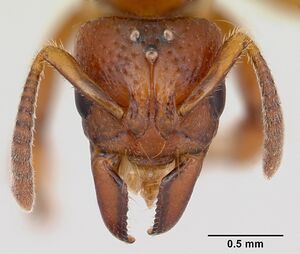Centromyrmex angolensis
| Centromyrmex angolensis | |
|---|---|

| |
| Scientific classification | |
| Kingdom: | Animalia |
| Phylum: | Arthropoda |
| Class: | Insecta |
| Order: | Hymenoptera |
| Family: | Formicidae |
| Subfamily: | Ponerinae |
| Tribe: | Ponerini |
| Genus: | Centromyrmex |
| Species: | C. angolensis |
| Binomial name | |
| Centromyrmex angolensis Santschi, 1937 | |
Recorded as being collected from termitaries of Apitermes and Protermes, though the range of prey is probably much wider.
Identification
A member of the feae species group. Closely related to Centromyrmex sellaris but worker and queen always with just a single spiniform seta at the inner apex of the metatibia, and always with a narrower head. In addition, the basal dentition of the mandible of angolensis can usually be distinguished from that of sellaris, as discussed under the latter name. (Bolton and Fisher 2008)
Keys including this Species
Distribution
Latitudinal Distribution Pattern
Latitudinal Range: 7.9° to -12.46062°.
| North Temperate |
North Subtropical |
Tropical | South Subtropical |
South Temperate |
- Source: AntMaps
Distribution based on Regional Taxon Lists
Afrotropical Region: Angola (type locality), Cameroun, Central African Republic, Democratic Republic of Congo, Gabon, Ghana, Ivory Coast, Liberia.
Distribution based on AntMaps
Distribution based on AntWeb specimens
Check data from AntWeb
Countries Occupied
| Number of countries occupied by this species based on AntWiki Regional Taxon Lists. In general, fewer countries occupied indicates a narrower range, while more countries indicates a more widespread species. |

|
Estimated Abundance
| Relative abundance based on number of AntMaps records per species (this species within the purple bar). Fewer records (to the left) indicates a less abundant/encountered species while more records (to the right) indicates more abundant/encountered species. |

|
Biology
Castes
Queen
Images from AntWeb
   
| |
| Queen (alate/dealate). Specimen code casent0417149. Photographer April Nobile, uploaded by California Academy of Sciences. | Owned by CAS, San Francisco, CA, USA. |
Nomenclature
The following information is derived from Barry Bolton's Online Catalogue of the Ants of the World.
- angolensis. Centromyrmex constanciae var. angolensis Santschi, 1937d: 214 (w.) ANGOLA.
- Type-material: holotype worker.
- Type-locality: Angola: Sangévé, 120 km. S. Nova Lisboa, i.-ii.1933 (A. Monard).
- Type-depository: NHMB.
- Bolton & Fisher, 2008c: 15 (q.m.).
- Subspecies of constanciae: Bolton, 1995b: 140.
- Status as species: Bolton & Fisher, 2008c: 15 (redescription).
- Distribution: Angola, Cameroon, Central African Republic, Democratic Republic of Congo, Gabon, Ghana, Ivory Coast, Liberia
Unless otherwise noted the text for the remainder of this section is reported from the publication that includes the original description.
Description
Worker
Bolton and Fisher (2008) - TL 4.3-6.2, HL 0.76-0.98, HW 0.78-1.00, CI 98-103, ML 0.49-0.70, MI 63-71, SL 0.58-0.74, SI 69-76, PW 0.58-0.82, WL 1.26-1.70 (30 measured).
With characters of the genus and the feae group. Head capsule in full-face view usually appears slightly longer than broad, sometimes about as long as broad, CI 103 or usually less. Mandibles smooth with scattered small punctures. Masticatory margin of mandible with 7–10 small, low indistinct teeth, reduced to mere crenulations or even more or less smooth in the proximal half when worn. Basal angle of mandible rounded, frequently without trace of a basal tooth but sometimes with a vestigial tooth. Dorsum of head with scattered punctures on smooth cuticle; on sides of head the punctures denser than on dorsum, and also with weak striation within the antennal fossae and on the sides, especially anteriorly. Extent of the striate component is variable. Metatibia with only normal setae dorsally but its anterior surface, at the apex and approximately opposite the pectinate spur, with a single, much stouter and sometimes more darkly coloured piniform seta. Petiole node in dorsal view broader than long. Pronotal dorsum, and anterior mesonotum, with widely scattered broad, shallow punctures that may be almost effaced. Pronotum dorsally also usually with variable weak oblique or arched faint disorganised sculpture, almost effaced in some specimens. Colour yellow to light brown.
Queen
Bolton and Fisher (2008) - TL 6.0-6.4, HL 0.94-0.96, HW 0.98-1.02, CI 104-106, OI 31-32, ML 0.63-0.65, MI 66-68, SL 0.70-0.74, SI 71-73, PW 0.94-0.96, WL 1.88-1.94 (4 measured). Very similar to the worker but the head averaging slightly broader. The queen will run out successfully in the key to workers. The unique worker character of a single thickly spiniform seta at the anterior apex of metatibia is duplicted in the queen caste.
Type Material
Holotype worker, ANGOLA: Sangévé (A. Monard) (Naturhistorisches Museum, Basel) [examined].
References
- Bolton, B. and B. L. Fisher. 2008c. Afrotropical ants of the ponerine genera Centromyrmex Mayr, Promyopias Santschi gen. rev. and Feroponera gen. n., with a revised key to genera of African Ponerinae (Hymenoptera: Formicidae). Zootaxa 1929: 1-37. PDF
- Santschi, F. 1937d. Résultats de la Mission scientifique suisse en Angola (2me voyage) 1932-1933. Fourmis angolaises. Rev. Suisse Zool. 44: 211-250.
References based on Global Ant Biodiversity Informatics
- Bolton B., and B. L. Fisher. 2008. Afrotropical ants of the ponerine genera Centromyrmex Mayr, Promyopias Santschi gen. rev. and Feroponera gen. n., with a revised key to genera of African Ponerinae (Hymenoptera: Formicidae). Zootaxa 1929: 1-37.
- Bolton, B., and B. L. Fisher. "Afrotropical ants of the ponerine genera Centromyrmex Mayr, Promyopias Santschi gen. rev. and Feroponera gen. n., with a revised key to genera of African Ponerinae (Hymenoptera: Formicidae)." Zootaxa 1929 (2008): 1-37. Abstract
- Santschi F. 1937. Résultats de la Mission scientifique suisse en Angola (2me voyage) 1932-1933. Fourmis angolaises. Revue Suisse de Zoologie. 44: 211-250.

